Keywords
|
| Orthogonal Frequency Division Multiplexing (OFDM), Multiple Input Multiple Output (MIMO), Peak to Average Power Ratio (PAPR), Selected Mapping (SLM), Partial Transmit Sequence (PTS) and Modified Constant Modulus Algorithm (MCMA). |
INTRODUCTION
|
| MIMO OFDM is a key technology for next generation wireless communication. Nowadays, 3G mobile communication systems became popular all over the world. Some of the 3G technologies are Wideband Code Division Multiple Access (WCDMA) - 384Kbps, CDMA 2000 - 384Kbps. High Speed Downlink/Uplink Packet Access - 5 to 30Mbps (HSDPA/HSUPA) and Evolution Data Optimized (EVDO) -5 to 30Mbps are 3.5G mobile technologies. However, its services cannot provide a very high dynamic range of data rates. In telecommunication systems, 4G is the fourth generation of wireless mobile communication technology standards. It is the upgraded version of the third generation (3G) standards. Technologies employed by 4G may include Cognitive Radio receivers, Orthogonal Frequency Division Multiple Access/Multiplexing (OFDMA/OFDM), Multiple Input/Multiple Output (MIMO), Universal Mobile Telecommunication System (UMTS), Time Division-Synchronous Code Division Multiple Access (TD-SCDMA). 4G technologies are characterized by their high data rate and packet switching transmission whereas 3G technologies are characterized by the combination of circuit and packet switching transmission. |
| The Mobile Worldwide Interoperability for Microwave Access (WiMAX) standard and the first release Long Term Evolution (LTE) standard are the two emerging 4G technologies for high speed mobile broadband internet service. Still there is a bandwidth resource scarcity exists in 4G technologies. So in order to improve the spectral efficiency and to achieve higher speed data rate transmission, an effective and efficient technology should be introduced. Also the drawback of existing modulation schemes cannot provide increased data rate. Hence, next generation mobile communication systems need sophisticated modulation scheme and information transmission structure. MIMO and OFDM have therefore been adopted due to their superior performance. They promise to become a very high speed wireless communication technology and combining them can provide an evolution from 3G to 4G in wireless industry. |
| However, the major drawback in MIMO OFDM is high peak to average power ratio problem. A low PAPR allows the transmit power amplifier to operate efficiently. A high PAPR forces the transmit power amplifier to have a large back off in order to ensure linear amplification of the signal. A high PAPR requires high resolution A/D conversion which places a complexity and power burden on the receiver front end. In this paper, we study about various PAPR reduction schemes. The rest of this paper is organized as follows. In Section II, MIMO OFDM system model is introduced. Section III presents various PAPR reduction schemes. Section IV describes the SLM, PTS and MCMA to reduce high PAPR. In Section V simulation results are presented and also a conclusion is drawn. |
MIMO OFDM SYSTEM MODEL
|
| In high-speed wireless communication, combining MIMO and OFDM technology, OFDM can be applied to transform frequency-selective MIMO channel into parallel flat MIMO channel, reducing the complexity of the receiver, through multipath fading environment can also achieve high data rate robust transmission. Therefore, MIMO-OFDM systems obtain diversity gain and coding gain by space-time coding, at the same time, the OFDM system can be realized with simple structure. Therefore, MIMO-OFDM system has become a welcome proposal for 4G mobile communication systems. The basic structure of MIMO OFDM system model is shown in figure 1. |
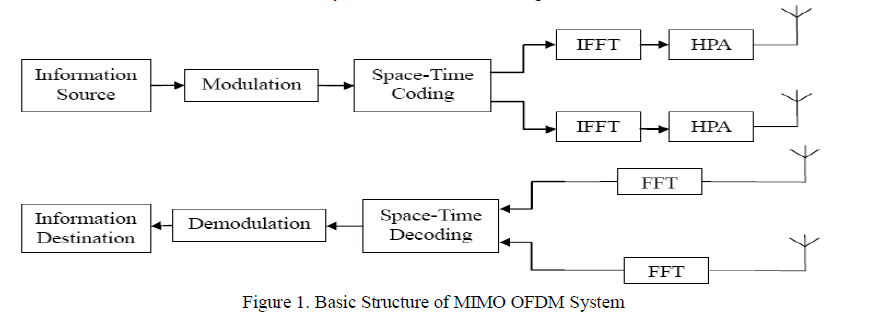 |
| At the transmitting end, a number of transmission antennas are used. An input data bit stream is supplied into spacetime coding, then modulated by OFDM and finally fed to antennas for sending out (radiation). At the receiving end, incoming signals are fed into a signal detector and processed before recovery of the original signal is made. |
PAPR REDUCTION SCHEMES
|
| Theoretically, large peaks in OFDM system can be expressed as Peak-to-Average Power Ratio, or referred to as PAPR, in some literatures, also written as PAR. It is usually defined as: |
 |
| PAPR depends on modulation schemes, oversampling factor and number of subcarriers. There are different kinds of PAPR reduction Schemes. They are: |
| 1. Distortion Schemes (Clipping and Filtering) |
| 2. Scrambling Schemes |
| 3. Coding Schemes |
| The clipping technique employs clipping or nonlinear saturation around the peaks to reduce the PAPR. It is simple to implement, but it may cause in-band and out-of-band interferences while destroying the orthogonality among the subcarriers. This particular approach includes block-scaling technique, clipping and filtering technique, peak windowing technique, peak cancellation technique, Fourier projection technique, and decision-aided reconstruction technique. |
| The coding technique is to select such code words that minimize or reduce the PAPR. It causes no distortion and creates no out-of-band radiation, but it suffers from bandwidth efficiency as the code rate is reduced. It also suffers from complexity to find the best codes and to store large lookup tables for encoding and decoding, especially for a large number of subcarriers. Golay complementary sequence, Reed Muller code, M-sequence, or Hadamard code can be used in this approach. |
| The probabilistic (scrambling) technique is to scramble an input data block of the OFDM symbols and transmit one of them with the minimum PAPR so that the probability of incurring high PAPR can be reduced. While it does not suffer from the out-of-band power, the spectral efficiency decreases and the complexity increase as the number of subcarriers increases. Furthermore, it cannot guarantee the PAPR below a specified level. This approach includes SLM (Selective Mapping), PTS (Partial Transmit Sequence), TR (Tone Reservation), and TI (Tone Injection) techniques. |
SCRAMBLING SCHEMES VERSUS MCMA
|
| The emergence of high peak power signal in OFDM system is due to the superposition (IFFT operation) of multiple sub-carrier signals. If multiple sequences which carry the same information are used to represent one transmission process, then the best one can be chosen among those candidates for a given PAPR threshold condition. In this way the occurrence probability of peak power signal can significantly be reduced. |
| A. Selective Mapping Scheme |
| The figure 2 shows the block diagram of selective mapping scheme. The following are the steps involved in SLM scheme: |
 |
 |
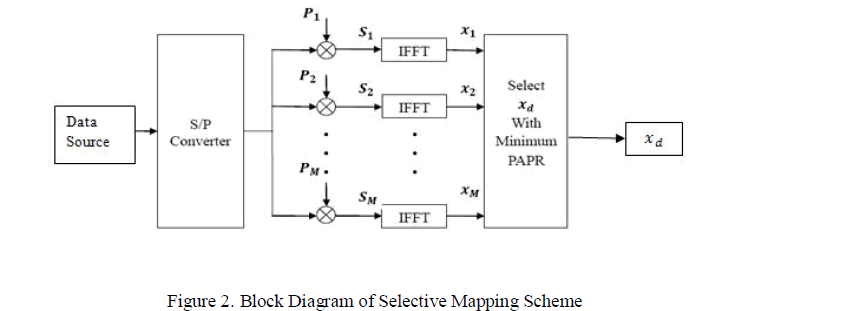 |
| B. Partial Transmit Sequence Scheme |
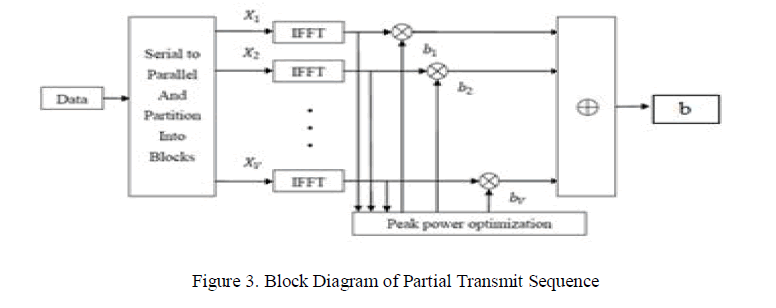 |
| C. Modified Constant Modulus Algorithm |
| The MCMA for PAPR reduction was developed from the well known Constant Modulus Algorithm. Consider the transmit signal model as shown in the figure 4. Here an OFDM block contains N number of subcarriers. These Subcarriers comprise Nus useful subcarriers with two guard bands. Again these useful subcarriers are further divided into M resource blocks each consisting of Nrb = Nus/M subcarriers. Pilot subcarriers act as training symbols. Data in these resource blocks are converted to space time domain using an IFFT. |
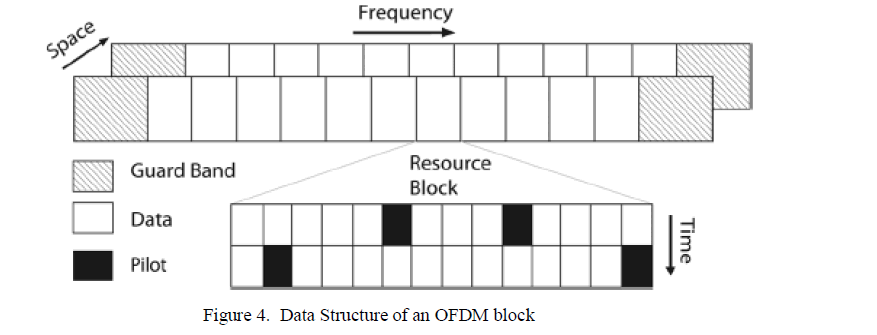 |
| Let us consider the data model as shown in the figure 5 |
 |
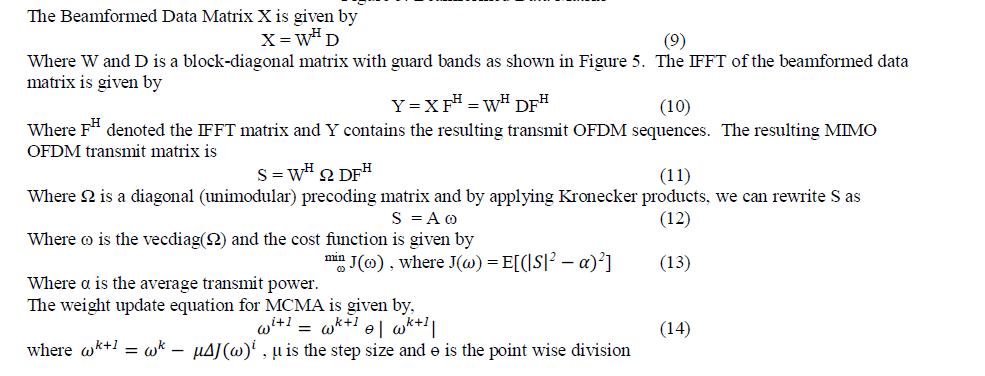 |
SIMULATION RESULTS
|
| The performance of PAPR reduction is analysed using MATLAB simulation package. Figure 6 shows the simulation result of comparison of PAPR reduction using SLM and PTS method to an OFDM system, separately. In PTS method, we set the number of sub-carriers N = 1024, number of sub blocks V=4, oversampling factor L=4 and applying pseudorandom partition scheme, for each carrier, adopting QPSK constellation mapping weighting factor bv [±1,±j] ; In SLM method, we set number of subcarriers N=1024, number of blocks M=4, oversampling factor L=4 and rotation factor Pm,n [±1,±j] . Based on the theory, we know that the IFFT calculation amount of these two methods is same when V = M, but for PTS method, it can provide more signal manifestations, thus, PTS method should provide a superior performance on PAPR reduction. In fact, this deduction is confirmed by simulation result. From the Figure 6, we learned that a PAPR reduction of about 2 dB is achieved through SLM and a 3dB reduction is achieved through PTS. |
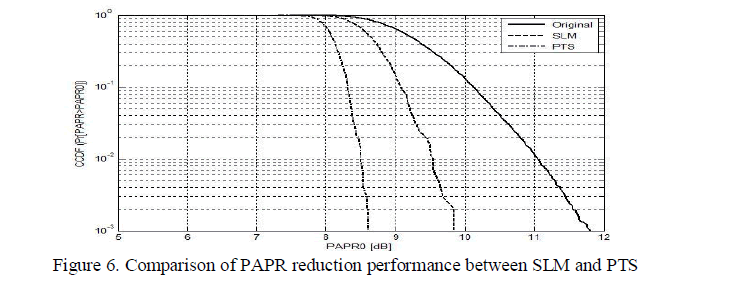 |
| In PTS method, if the collection range of weighting factor is W, then for V sub-blocks, the system exists Wv−1 types of auxiliary information sequence, so the number of redundant bits is Rap=(V−1)log2(M-1). By the same token, in SLM method, if the length of sequence Pm is M, then in SLM-OFDM system, it requires redundant bitsRap=log2(M−1). As can be seen from Table 1, under the same circumstances, PTS method requires a higher information redundancy, compared to SLM algorithm. |
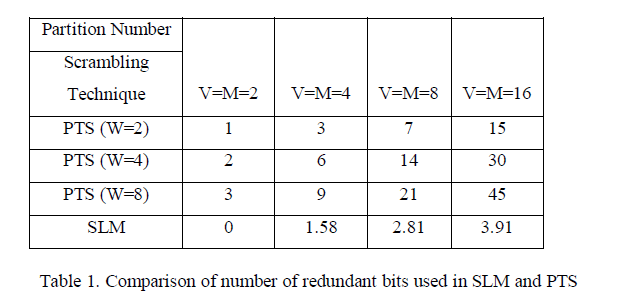 |
| Since there exists complexity in SLM and PTS as they require M number of IFFT and V number of IFFT calculations respectively. Hence we go for MCMA to reduce PAPR with a less complexity. In MCMA, the simulation parameters used are number of subcarriers N=1024, M=60 resource blocks, Nrb = 14 subcarriers, Nus = 840 data carriers. The convergence property of MCMA is shown in figure 7. |
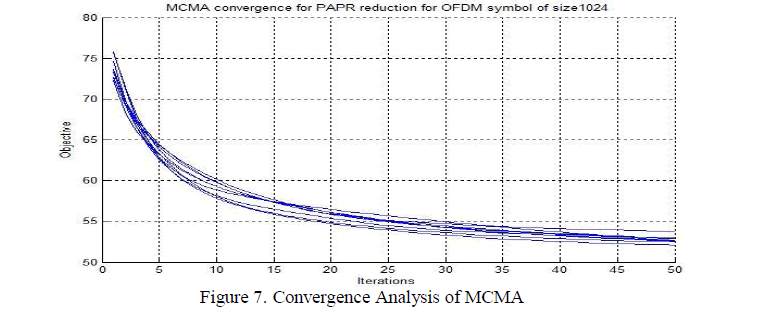 |
| From figure 7, it shows that the convergence of MCMA is fast and good and from figure 8, it shows that there exists a 3.5 dB PAPR reduction using MCMA . |
 |
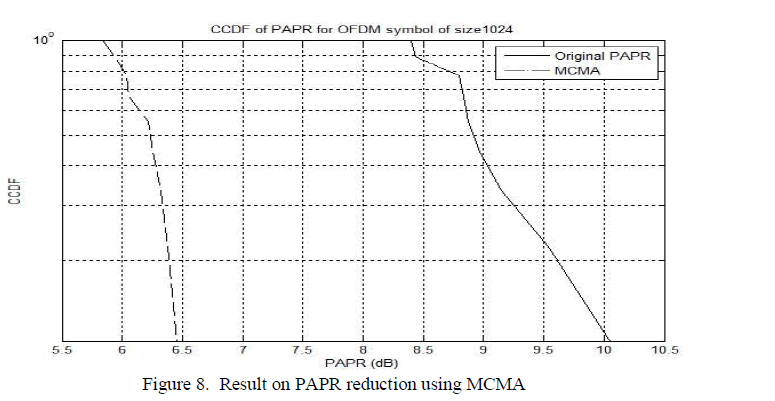 |
CONCLUSION
|
| In the signal scrambling technology, we have study the method of selected mapping and partial transmit sequence. Also we have compared these two schemes under the same conditions in general. We achieved a PAPR reduction of about 2dB using SLM and 3dB using PTS. Hence, we have analyzed that the PAPR reduction performance of PTS is better than that of SLM. We also analyzed the convergence property of MCMA and its PAPR reduction performance. We achieved a PAPR reduction of about 3.5 dB using MCMA. The performance of PAPR reduction in MCMA is better than that of PTS. |
References
|
- Bauml, R.W, Fischer, R.F.H and Huber, J.B, (Oct 1996), “Reducing the peak-to-average power ratio of multicarrier modulation by selectedmapping,” IEEE Electronic Letters, vol. 32, no. 22, pp. 2056-2057.
- Christopher Gerald Santos, (July 2002), “Peak-to-Average power ratio reduction solutions for OFDM,” Philippine Journal of ICT andMicroelectronics, vol. 1, no.2.
- Cooper, G.R, Nettleton, R.W, (Nov 1978), “A spread spectrum technique for high capacity mobile communications,” IEEE Transaction onVehicular Technology vol. 27, no. 4, pp. 264-275.
- Davis, J.A, Jedwab, J, (Feb 1997), “Peak-to-Mean power control and error correction for OFDM transmission using Golay sequences andReed-Muller codes,” IEEE Electronic Letters, vol. 33, no. 4, pp. 267-268.
- H. Sampath, et al., (Sep 2002), “A fourth-generation MIMO-OFDM broadband wireless system: design, performance and field trial results,”IEEE Communication Magazine, vol. 40, no. 9, pp. 143-149.
- Jayalath, A.D.S, Tellainbura, C, (Sep 2003), “Side Information in PAR Reduced PTS-OFDM Signals,” Proceedings 14th IEEE Conference onPersonal, Indoor and Mobile Radio Communications, vol. 1, pp. 226-230.
- Jones, A.E, Wilkinson, T.A, Barton, S.K, (Dec 1994), “Block coding scheme for reduction of peak to mean envelope power ratio ofmulticarrier transmission scheme,” IEEE Electronic Letters, vol. 30, no. 25, pp. 2098-2099.
- Leonard J. Cimini, Jr., Nelson R. Sollenberger, (Mar 2000), “Peak-to-Average power ratio reduction of an OFDM signal using partial transmitsequences,” IEEE Electronic Letters, vol. 4, no. 3, pp. 88-86.
- L. Wang and Y. Cao, (July 2008), “Sub-optimum PTS for PAPR reduction of OFDM signals,” IEEE Electronics Letters, vol. 44, no. 15, pp.921-922.
- Mohinder Jankiraman, (2004), “MIMO system capacity” in Space-time codes and MIMO systems, Artech House, pp. 23.
- Mohinder Jankiraman, (2004), “Peak to average power ratio” in Space-time codes and MIMO systems, Artech House, pp. 201.
- Oh-Ju Kwon and Yeong-Ho Ha, (June 2003), “Multi-carrier PAP reduction method using sub-optimal PTS with threshold,” IEEETransactions on Broadcasting, vol. 49, no. 2, pp. 232-235.
- S. H. Muller, J. B. Huber, (Feb 1997), “OFDM with reduced peak-to-average power ratio by optimum combination of partial transmitsequence,” IEEE Electronic Letters, Vol. 33, No. 5, pp. 368-369.
- S. H. Muller, J. B. Huber, (Feb 1997), “A novel peak power reduction scheme for OFDM,” The 8th IEEE International Symposium onPersonal, Indoor and Mobile Radio Communications, pp. 1090–1094.
|